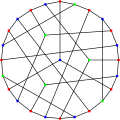Coxeter graph
| Coxeter graph | |
|---|---|
|
The Coxeter graph | |
| Vertices | 28 |
| Edges | 42 |
| Radius | 4 |
| Diameter | 4 |
| Girth | 7 |
| Automorphisms | 336 (PGL2(7)) |
| Chromatic number | 3 |
| Chromatic index | 3 |
| Properties |
Symmetric Distance-regular Distance-transitive Cubic Hypohamiltonian |
In the mathematical field of graph theory, the Coxeter graph is a 3-regular graph with 28 vertices and 42 edges.[1] All the cubic distance-regular graphs are known.[2] The Coxeter graph is one of the 13 such graphs.
Properties
The Coxeter graph has chromatic number 3, chromatic index 3, radius 4, diameter 4 and girth 7. It is also a 3-vertex-connected graph and a 3-edge-connected graph.
The Coxeter graph is hypohamiltonian : it does not itself have a Hamiltonian cycle but every graph formed by removing a single vertex from it is Hamiltonian. It has rectilinear crossing number 11, and is the smallest cubic graph with that crossing number currently known, but an 11-crossing, 26-vertex graph may exist (sequence A110507 in OEIS).
Construction
The simplest construction of a Coxeter graph is from a Fano plane. Take the 7C3 = 35 possible 3-combinations on 7 objects. Discard the 7 triplets that correspond to the lines of the Fano plane, leaving 28 triplets. Link two triplets if they are disjoint. The result is the Coxeter graph.
The Coxeter graph may also be constructed from the smaller distance-regular Heawood graph by constructing a vertex for each 6-cycle in the Heawood graph and an edge for each disjoint pair of 6-cycles.[3]
The Coxeter graph may be derived from the Hoffman-Singleton graph. Take any vertex v in the Hoffman-Singleton graph. There is an independent set of size 15 that includes v. Delete the 7 neighbors of v, and the whole independent set including v, leaving behind the Coxeter graph.
Algebraic properties
The automorphism group of the Coxeter graph is a group of order 336.[4] It acts transitively on the vertices, on the edges and on the arcs of the graph. Therefore the Coxeter graph is a symmetric graph. It has automorphisms that take any vertex to any other vertex and any edge to any other edge. According to the Foster census, the Coxeter graph, referenced as F28A, is the only cubic symmetric graph on 28 vertices.[5]
The Coxeter graph is also uniquely determined by its graph spectrum, the set of graph eigenvalues of its adjacency matrix.[6]
As a finite connected vertex-transitive graph that contains no Hamiltonian cycle, the Coxeter graph is a counterexample to a variant of the Lovász conjecture, but the canonical formulation of the conjecture asks for an Hamiltonian path and is verified by the Coxeter graph.
Only five examples of vertex-transitive graph with no Hamiltonian cycles are known : the complete graph K2, the Petersen graph, the Coxeter graph and two graphs derived from the Petersen and Coxeter graphs by replacing each vertex with a triangle.[7]
The characteristic polynomial of the Coxeter graph is  . It is the only graph with this characteristic polynomial, making it a graph determined by its spectrum.
. It is the only graph with this characteristic polynomial, making it a graph determined by its spectrum.
Gallery
-

The graph obtained by any edge excision from the Coxeter is Hamilton-connected.
-

The chromatic number of the Coxeter graph is 3.
-

The rectilinear crossing number of the Coxeter graph is 11.
References
- ↑ Weisstein, Eric W., "Coxeter Graph", MathWorld.
- ↑ Brouwer, A. E.; Cohen, A. M.; and Neumaier, A. Distance-Regular Graphs. New York: Springer-Verlag, 1989.
- ↑ Dejter, Italo J. (2011), "From the Coxeter graph to the Klein graph", Journal of Graph Theory, arXiv:1002.1960, doi:10.1002/jgt.20597.
- ↑ Royle, G. F028A data
- ↑ Conder, M. and Dobcsányi, P. "Trivalent Symmetric Graphs Up to 768 Vertices." J. Combin. Math. Combin. Comput. 40, 41-63, 2002.
- ↑ E. R. van Dam and W. H. Haemers, Spectral Characterizations of Some Distance-Regular Graphs. J. Algebraic Combin. 15, pages 189-202, 2003
- ↑ Royle, G. "Cubic Symmetric Graphs (The Foster Census)."
- Coxeter, H. S. M. "My Graph." Proc. London Math. Soc. 46, 117-136, 1983.
